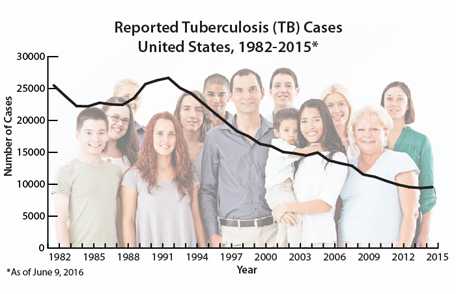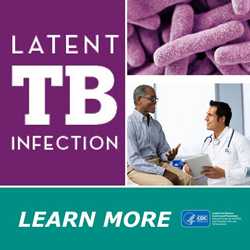Burden of TB in the United States
 Increase in Reported TB Cases in 2015
Increase in Reported TB Cases in 2015
Although tuberculosis (TB) is preventable and curable, many people in the United States still suffer from this disease. Persons with TB disease can be found in every state; in rural areas and cities; and in schools, workplaces, and many other places where people are in close contact. TB bacteria usually attack the lungs, but can also attack any part of the body such as the kidney, spine, and brain. Not everyone infected with TB bacteria becomes sick. As a result, two TB-related conditions exist: latent TB infection and TB disease. If not diagnosed and treated properly, TB disease can be fatal. One of CDC’s roles in addressing TB in the United States is to collect surveillance data and use that data to influence strategies to eliminate TB.
Highlights from the 2015 TB Surveillance Report
- For the first time in 23 years, the number of TB cases in the United States increased in 2015.
- A total of 9,557 cases of TB disease were reported in 2015, which represents a 1.6% increase from 2014.
- An increase in TB cases was reported in 27 states and the District of Columbia.
- The overall TB case rate remained level at 3.0 per 100,000 persons.
- Since 1993, TB case rates have continued to decline in almost all racial and ethnics groups.
- People born outside of the United States continue to bear the burden of TB, largely because of reactivation of latent TB infection that occurred in their country of origin. The majority of these cases are among persons who have been in the United States 5 years or longer.
Eliminating TB in the United States
The first increase in TB cases in the United States in 23 years underscores the need for more comprehensive public health approaches in TB prevention and control. To eliminate TB in the United States, multiple strategies are needed, including:
- Increased testing and treatment of latent TB infection,
- Greater efforts to reach populations most affected by TB, and
- Reducing TB transmission through effective diagnostic and treatment strategies.

Clinician speaking with patient.
Increased Testing and Treatment of Latent TB Infection
Millions of people in the United States have latent TB infection. People with latent TB infection have been infected with TB germs, but do not feel sick, do not have symptoms, and cannot spread TB to others. If their TB germs become active and multiply, they can develop TB disease. More than 85% of TB cases in the United States are now estimated to be associated with longstanding, untreated latent TB infection. The majority of these cases occur among individuals who were born outside the United States and were infected many years earlier. CDC and the United States Preventive Services Task Force (USPSTF) recommend testing populations that are at increased risk for TB infection. These groups include:
- People born in or who have lived in countries where TB disease is common; and
- People who live or have lived in large group settings, such as homeless shelters or prisons and jails where TB is more common.
CDC also recommends testing for TB infection for other high-risk groups. These groups include:
- Health care workers and others who work in places at high risk for TB transmission, such as hospitals, homeless shelters, correctional facilities, nursing homes, and residential homes for those with HIV.
- Persons who have spent time with someone who has infectious TB disease.
Others with weaker immune systems, such as those with certain health conditions or taking certain medications, have a higher risk of developing TB disease once infected. Testing for TB infection should be part of their regular medical care.
Children, especially those under age 5, have a higher risk of developing TB disease once infected. Therefore, testing for TB infection in children is important if they are in one of the risk groups noted above.
Addressing Disparities
Intensified efforts are needed to address the persistent disparities that exist between U.S.-born and foreign-born persons, as well as among U.S.-born racial and ethnic minorities.
Many of those at high risk for latent TB infection or TB disease do not traditionally receive care in health departments — but are seen by private community providers and community health centers. Engaging these partners will be critical to future success in eliminating TB.
Next Steps
Together, we can send a clear signal that TB can be eliminated in the United States with continued prevention and control efforts, along with targeted testing of high-risk populations. To learn more, visit the CDC TB Website or follow us on Facebook and Twitter.
More Information
More Information
References
- CDC. Reported Tuberculosis in the United States, 2015. Atlanta, GA: U.S. Department of Health and Human Services, CDC, November 2016.
- CDC. Latent TB Infection Resources
- CDC. The Difference Between Latent TB Infection and TB Disease
- State TB Control Offices
- Page last reviewed: December 19, 2016
- Page last updated: December 20, 2016
- Content source:
- National Center for HIV/AIDS, Viral Hepatitis, STD, and TB Prevention
- Page maintained by: Office of the Associate Director for Communication, Digital Media Branch, Division of Public Affairs




 ShareCompartir
ShareCompartir
